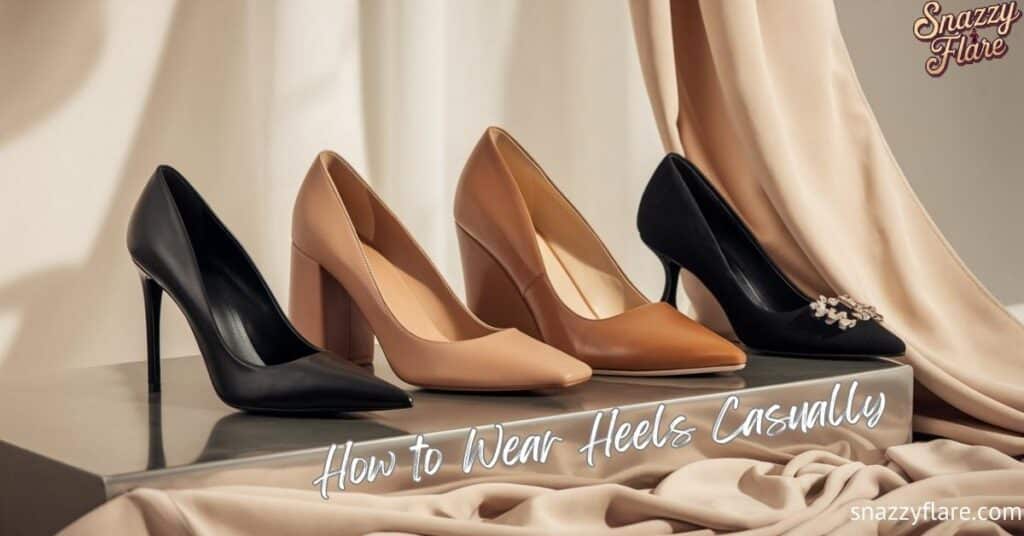Whether you’re a heel wearing pro or just starting your journey into elevated footwear, this comprehensive guide will help you navigate the world of heels with confidence and style. From choosing the right pair to mastering the perfect strut, we’ll cover everything you need to know about how to wear heels for any occasion.
Understanding Different Types of Heels
Before diving into styling tips, let’s explore the main categories of heeled shoes and their ideal uses:
Stiletto Heels: The Classic Statement
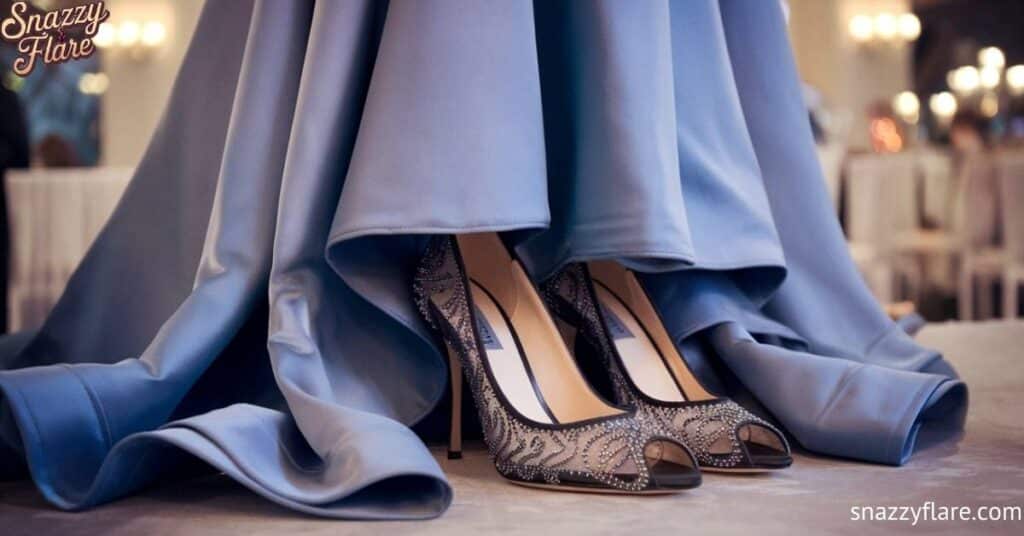
The stiletto heel remains fashion’s most iconic silhouette. These thin heeled showstoppers typically range from 2 to 4 inches in height and work best for:
Formal Events and Galas
For formal events and galas, stilettos and high heels create an elevated, polished look that’s ideal for upscale gatherings. Choose slender, statement heels in classic shades like black or nude to complement formal attire without overpowering it. Ensure heel heights between 3-4 inches to exude elegance while maintaining balance, ideal for occasions where standing and mingling are typical.
Date Nights
Date nights call for heels that balance style and comfort, like a 2-3 inch stiletto or kitten heel. These options add height while ensuring ease for longer wear, allowing you to focus on enjoying the evening. Consider romantic colors like blush, burgundy, or classic black, paired with simple, chic dresses or tailored outfits that complete the look without drawing attention away from the heels.
Professional Settings (When Height Appropriate)
In professional settings, opt for heels around 2-3 inches to project confidence without sacrificing comfort. Classic block heels or kitten heels offer a sturdy base ideal for office settings, allowing for a refined yet comfortable look. Stick to neutral colors black, navy, and beige and closed-toe designs for a sleek, professional appearance that aligns with most workplace dress codes.
Special Occasions
For special occasions, go bold with unique heel designs like embellished stilettos or wedges. These eye-catching styles add flair to party outfits and elevate your look while ensuring wearability for extended hours. Prioritize materials like leather or suede for better breathability and durability, especially if the event involves prolonged standing or dancing.
What Are Occasion Dresses: When & Where to Wear Them
Pro Tip: For beginners, start with a 2-inch stiletto before graduating to higher heights.
Block Heels: Your Everyday Champion
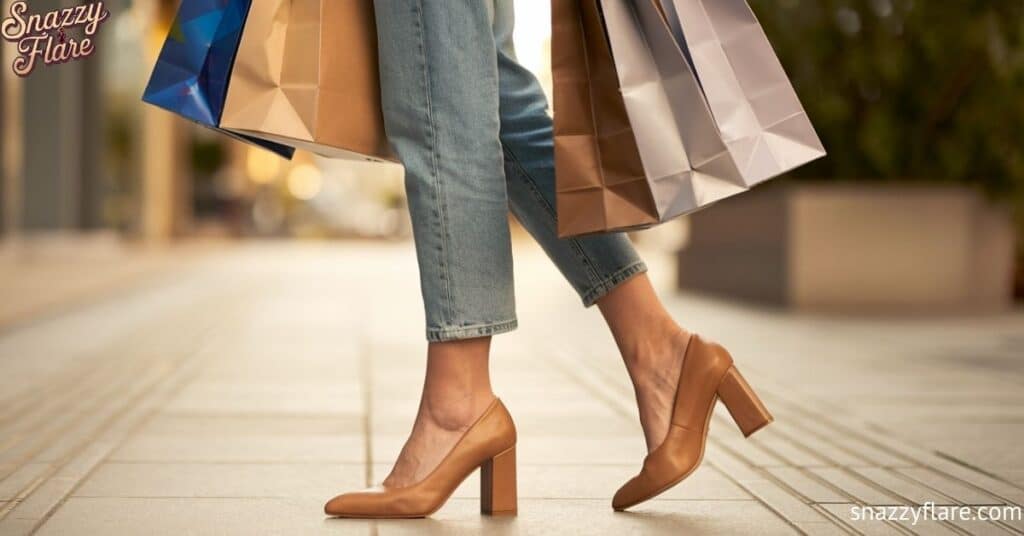
The block heel offers stability without sacrificing style. These comfortable heels feature:
Wide, Sturdy Base
Heels with a wide, sturdy base offer improved stability, making them perfect for longer wear without strain. Styles like block heels or wedge heels distribute weight evenly across the foot, reducing pressure on any single point. This design minimizes foot fatigue and makes it possible to wear heels for longer periods while retaining a stylish look.
Even Weight Distribution
Heels with even weight distribution provide essential support, especially for those new to wearing heels. Look for block or wedge heels, which allow your feet to sit comfortably rather than placing all the pressure on the balls of the feet. This balance reduces the risk of pain and strain, making these heels ideal for daily wear or situations requiring extended walking.
Versatile Styling Options
With versatile styling options, block and wedge heels can transition easily from day to night, pairing well with both formal and casual outfits. Choose neutral colors like black, tan, or navy for maximum flexibility, allowing you to style them with a range of looks from business attire to relaxed weekend wear.
Perfect for:
Office Wear
Office wear calls for sophisticated yet comfortable heels, like block heels or kitten heels, no taller than 2-3 inches. Stick with classic colors such as black, beige, or navy to match the professional environment. Prioritize styles with a closed toe for a polished look, providing comfort without compromising professionalism.
Shopping Trips
For shopping trips, opt for comfortable block or wedge heels with additional padding to support extended walking. Low to medium-height heels with a sturdy base are ideal, as they allow you to move easily from store to store. Styles with breathable materials such as leather or suede help keep feet cool and comfortable throughout the day.
Casual Outings
Heels can elevate any casual outing outfit, making it easy to achieve a stylish look with minimal effort. Try block heels, wedges, or kitten heels to add subtle height without looking overdressed. Match with denim or flowy dresses, creating a relaxed yet polished appearance perfect for brunches, errands, or meet-ups with friends.
Extended Walking Periods
For occasions involving extended walking periods, prioritize heavily cushioned wedge or block heels with adjustable straps. These styles offer both height and comfort, reducing foot strain and supporting natural movement. Avoid stilettos or narrow heels, as they tend to put additional pressure on the feet over long distances.
Do You Get Used to Heels? Here’s How to Do It
Wedge Heels: The Comfort Queen
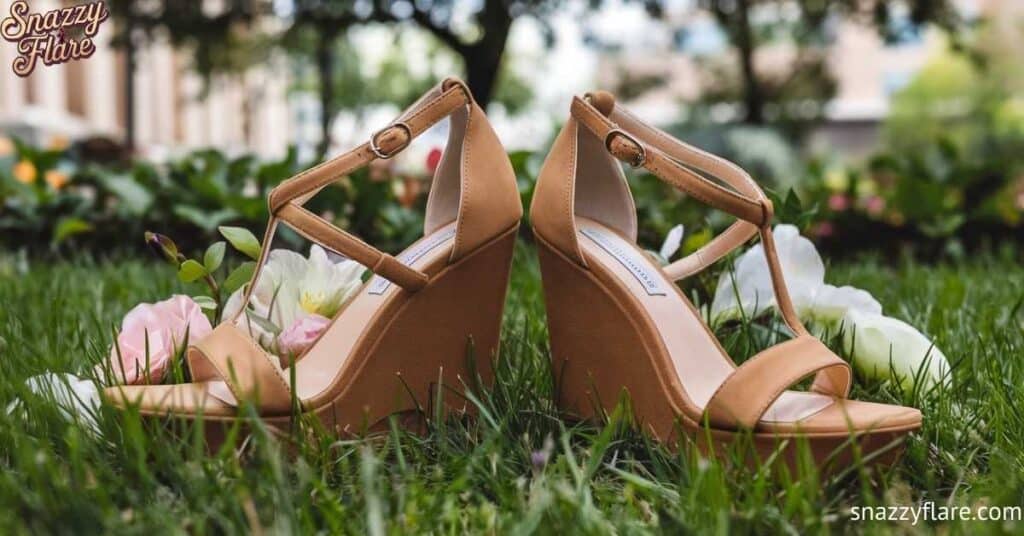
Wedge heels provide maximum stability and support, making them ideal for:
Outdoor Events
For outdoor events like picnics or garden parties, choose wedge heels or block heels to prevent sinking into soft ground. Look for shoes with textured or rubber soles for added grip, ensuring stability on uneven surfaces. Neutral shades or light colors work well for outdoor settings, keeping the overall look natural and elegant.
Summer Parties
Summer parties pair well with wedge sandals or strappy heels in bright, fun colors. Choose breathable materials like leather or canvas to keep your feet cool in the heat. Styles with ankle support provide added security, making it easy to mingle and dance comfortably throughout the event.
Beach Weddings
For beach weddings, wedges or flat sandals with a bit of height add style without compromising stability. Opt for materials like cork or espadrille, which offer durability and comfort on sandy surfaces. Avoid stilettos, as they sink into the sand and make movement challenging; instead, go for designs with delicate straps or floral embellishments that fit the occasion.
Extended Wear
Heels meant for extended wear should be comfortable and supportive, such as block heels or wedges with padded insoles. Consider styles with adjustable straps and breathable materials, which help maintain foot health over long hours. Neutral colors offer versatility, allowing these heels to pair well with various outfits and events.
Kitten Heels: The Elegant Compromise
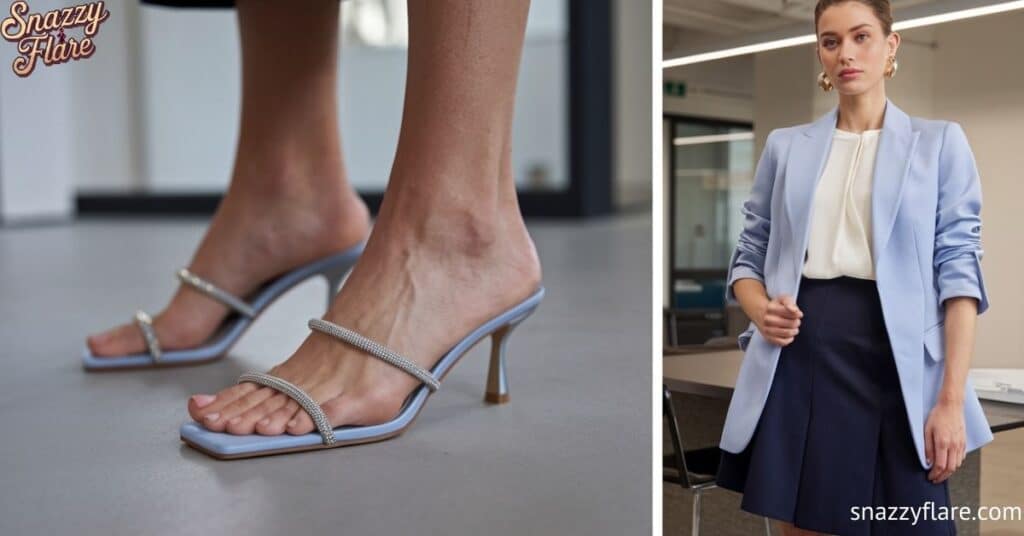
The kitten heel typically measures 1.5-2 inches, offering:
Classic Sophistication
Heels that exude classic sophistication such as kitten heels or low block heels add subtle elegance to your look without overpowering it. Their understated height and sleek design make them perfect for achieving a refined, polished appearance suitable for both formal and professional settings.
All-Day Comfort
For all-day comfort, choose heels with low to medium heights, padded insoles, and ample arch support. Styles like kitten heels or chunky block heels are designed to provide comfort while maintaining style, making them ideal for events or workdays that require extended wear.
Professional Appropriateness
In professional settings, opt for closed-toe, neutral colored heels around 1.5-2 inches in height. Heels like these keep the look formal without drawing attention away from your outfit, aligning well with a business-casual or corporate dress code.
Easy Walking Ability
Heels with easy walking ability like block or kitten heels offer stability, balance, and reduced pressure on the feet. Their lower height and broad base make them great for walking comfortably while retaining a graceful appearance, even over longer distances.
Building Your Heel Collection
When starting your heel wardrobe, focus on these essential styles:
| Heel Type | Essential Color | Occasion | Comfort Level |
| Block Heel Pump | Black | Work/Casual | High |
| Nude Stiletto | Skin-tone match | Versatile | Medium |
| Wedge Sandal | Tan/Natural | Casual/Outdoor | High |
| Kitten Heel Slingback | Navy/Black | Professional | High |
The Art of Wearing Heels Casually
Many wonder if it’s possible to wear casual heels without looking overdressed. The answer is absolutely yes! Here’s how to master casual footwear with elevation:
Pairing Heels with Denim
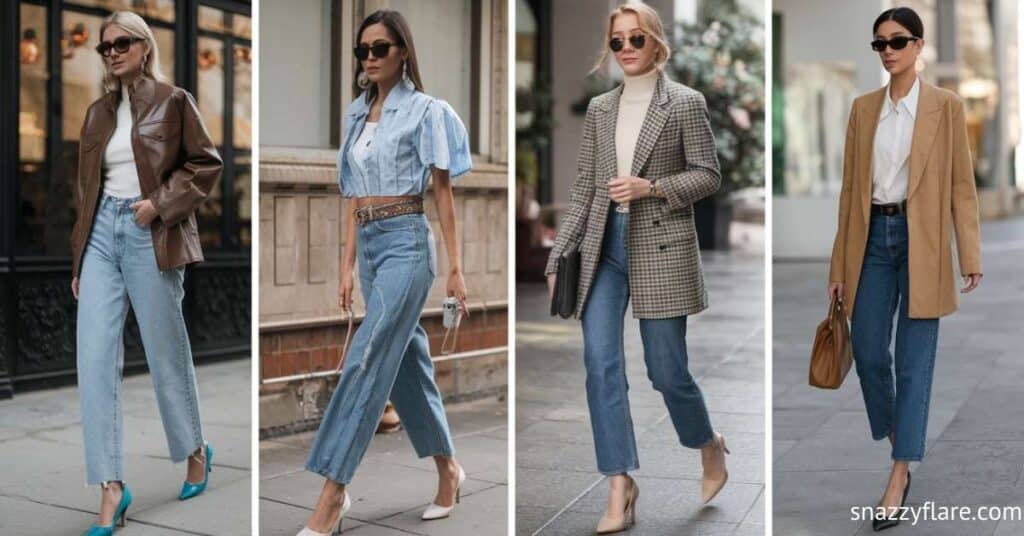
Denim outfits provide the perfect canvas for casual heel styling:
- Pairing straight-leg jeans with block heels creates a balanced and chic look that offers both height and stability. This combo adds a modern edge to your outfit and is perfect for a casual day out or an evening meet up.
- Cropped denim pairs effortlessly with kitten heels, providing a laid-back yet sophisticated vibe. This style highlights the ankles and adds a slight lift without compromising on comfort ideal for running errands or casual brunches.
- Boyfriend jeans with wedges bring a relaxed and airy look while giving your outfit height and structure. Wedges add balance and make this style suitable for outdoor gatherings or leisurely walks.
- Skinny jeans paired with stilettos create a streamlined, elongating effect, perfect for a night out or formal event. The sleekness of stilettos complements the fit of skinny jeans, delivering a bold, refined silhouette.
Creating Balance with Oversized Pieces
Balance is key when wearing heeled outfits casually:
Oversized Sweater + Skinny Jeans + Block Heels
An oversized sweater with skinny jeans and block heels achieves a cozy, trendy look that’s ideal for cooler days. The block heels add stability, while the fitted jeans balance the oversized top for a polished yet relaxed feel.
Loose Midi Dress + Kitten Heels
A loose midi dress with kitten heels strikes the perfect balance of comfort and elegance. This combination is ideal for daytime outings, offering both freedom of movement and a polished touch.
Wide-Leg Pants + Stilettos
Pairing wide-leg pants with stilettos creates a stunning, elongating effect that works well for formal or professional occasions. The high heel complements the flowy look of wide-leg pants, adding both height and elegance.
Boyfriend Blazer + Straight-Leg Denim + Wedges
A boyfriend blazer with straight-leg denim and wedges combines casual with structured style. The wedges give extra height, while the blazer adds a professional touch, making this a perfect smart-casual outfit.
Professional and Formal Occasions
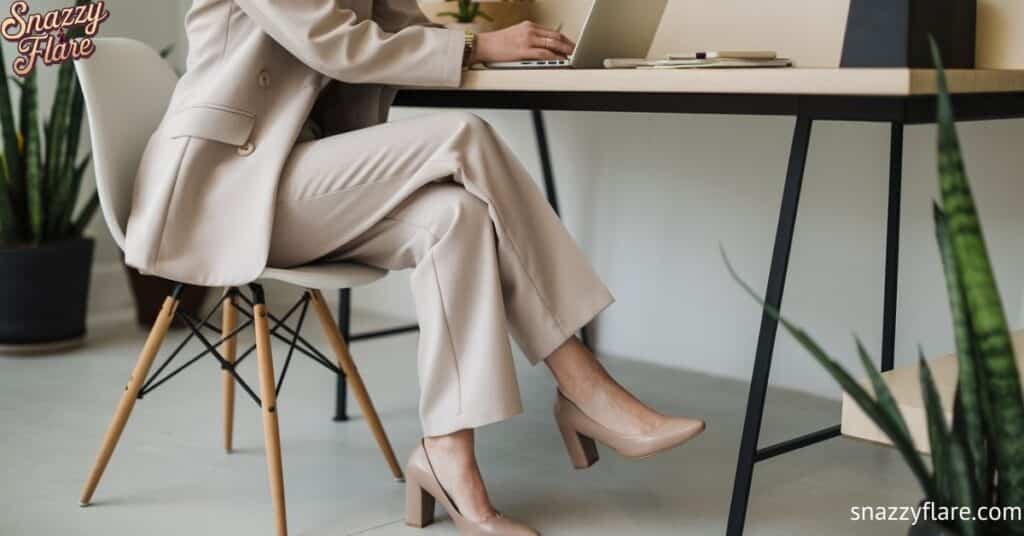
Mastering formal footwear requires understanding appropriate heel heights and styles for different settings:
Office Appropriate Choices
For professional wear, consider:
Maximum 3 Inch Heel Height
For the office, a maximum 3 inch heel height is ideal, balancing style with comfort. Heels this height provide a lift without overextending your feet, making them suitable for long wear in professional settings.
Closed-Toe Designs
Closed-toe designs offer a polished, professional look that fits into most corporate dress codes. They also provide added comfort and protection, especially in formal environments.
Classic Colors (Black, Navy, Nude)
Opt for classic colors like black, navy, or nude in heels for versatility and professionalism. These shades pair well with any outfit, making them an essential part of a work-friendly shoe collection.
Conservative Styling
Conservative styling in heels such as minimal embellishments and classic silhouettes ensures your look remains elegant without drawing too much attention. This approach is ideal for maintaining a refined image in formal settings.
Evening Events
For glamorous events, you can opt for:
Higher Heel Heights
For evening events, higher heel heights make a bold statement and add a touch of elegance to your outfit. They create an elongated look, especially with formal dresses or evening gowns.
Embellished Designs
Embellished designs in heels add glamour and sophistication, perfect for making a stylish entrance. Look for subtle accents or metallic elements to elevate your outfit with tasteful flair.
Statement Colors
Statement colors like red or metallic shades can make your heels the focal point of your outfit, great for events where you want to stand out. Pair these heels with neutral clothing for a balanced, eye catching look.
Open Toed Footwear
Open toed footwear is a stylish choice for warm weather events, allowing breathability while adding a chic, summery touch. This style works well with dresses, making it a favorite for evening events and formal gatherings.
What to wear if you can’t wear heels
The Comfort Factor: Making Heels Wearable
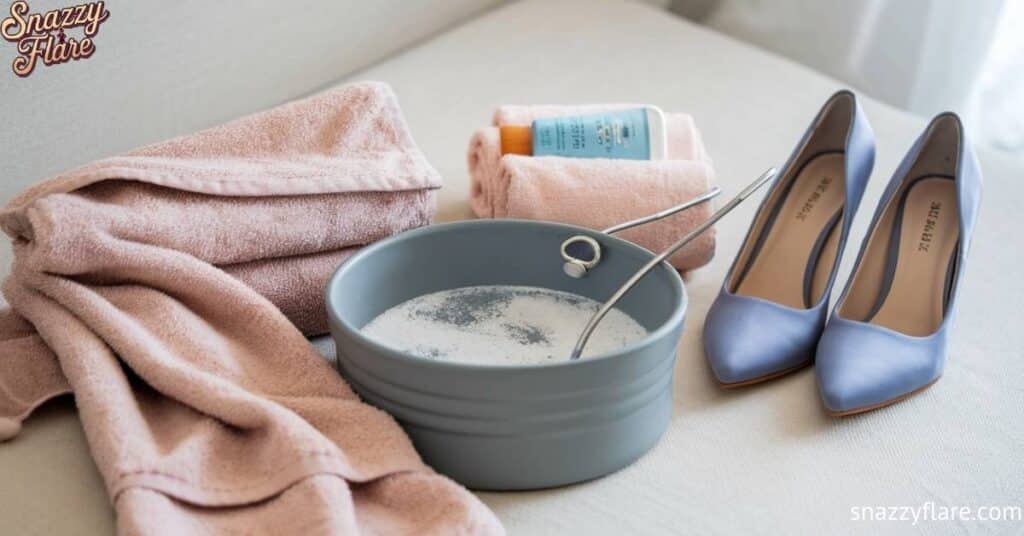
Prioritize comfort by choosing well-fitting, cushioned heels and balancing wear time to prevent foot strain.
Essential Comfort Accessories
Invest in these items for optimal heel comfort:
- Gel insoles provide extra cushioning, reducing the pressure on your feet and making heels more comfortable for extended wear. These insoles are a great investment for anyone who frequently wears heels.
- Ball-of-foot cushions help alleviate pressure on the forefoot area, making it easier to stand or walk in heels for long periods. They add a layer of comfort, especially useful for stilettos and other high heels.
- Heel grips keep your foot securely in place, preventing slipping and blisters at the back of the heel. They’re particularly beneficial for ensuring a snug fit in slightly loose shoes.
- Anti-slip pads on the sole of the heel provide traction, helping prevent slips on smooth surfaces. These pads enhance stability, allowing you to walk with more confidence.
Foot Care Routine for Heel Wearers
Maintain foot health with this routine:
- Evening Foot Soak.
An evening foot soak relaxes tired feet, reducing swelling and soothing soreness from wearing heels. Soaking your feet in warm water with Epsom salts can provide immediate relief after a long day. - Golf Ball Massage.
Rolling a golf ball under each foot helps release tension and stretch the foot muscles. This simple massage technique is an effective way to relieve stress after wearing heels. - Toe Stretches.
Toe stretches improve flexibility and reduce stiffness, counteracting the effects of wearing heels. Try spreading and bending your toes to keep them strong and relaxed. - Regular Moisturizing.
Regular moisturizing prevents dryness and cracking, keeping your feet soft and healthy. Hydrated skin is less prone to blisters, making it easier to wear heels comfortably.
Walking Technique and Posture
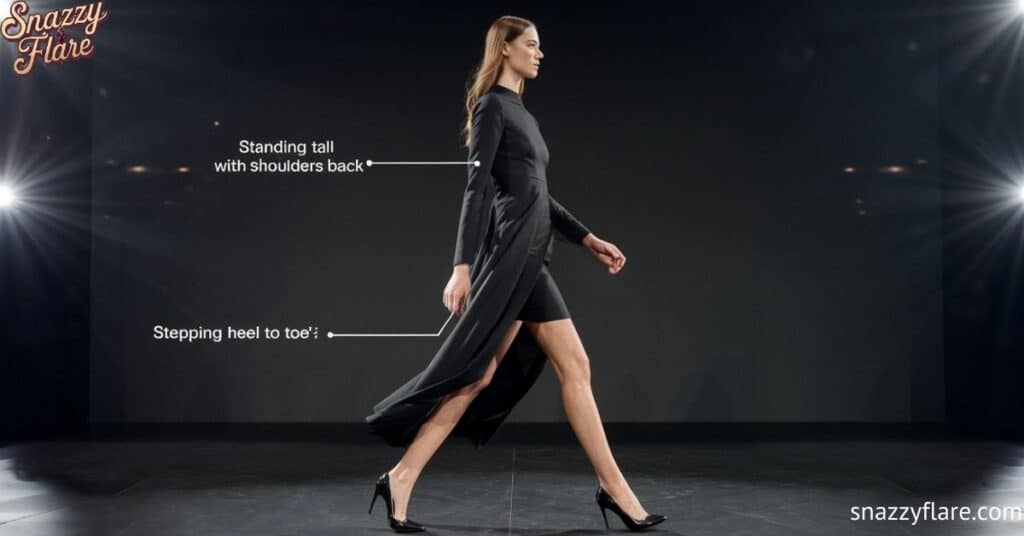
Stand tall, engage your core, and walk heel to toe in small steps for a poised, balanced stride in heels.
The Perfect Heels Walk
Master these steps for confident heel wearing:
- Stand Tall with Shoulders Back
To walk gracefully in heels, stand tall with your shoulders back and spine aligned. This posture not only looks elegant but also reduces strain on your lower back. - Step Heel to Toe
When walking, step heel to toe for a natural stride that provides stability and reduces impact on your feet. This technique helps you maintain balance in heels. - Take Smaller Steps
Take smaller steps to improve your stability and control. Smaller strides are more manageable in heels, making your walk look more composed and confident. - Keep Your Core Engaged
Engaging your core adds stability and helps you maintain proper posture. A strong core makes it easier to balance in heels and reduces the risk of stumbling. - Look Straight Ahead
To appear confident and avoid tripping, look straight ahead as you walk. Focusing forward allows you to maintain your balance and project an air of self-assurance.
Common Walking Mistakes
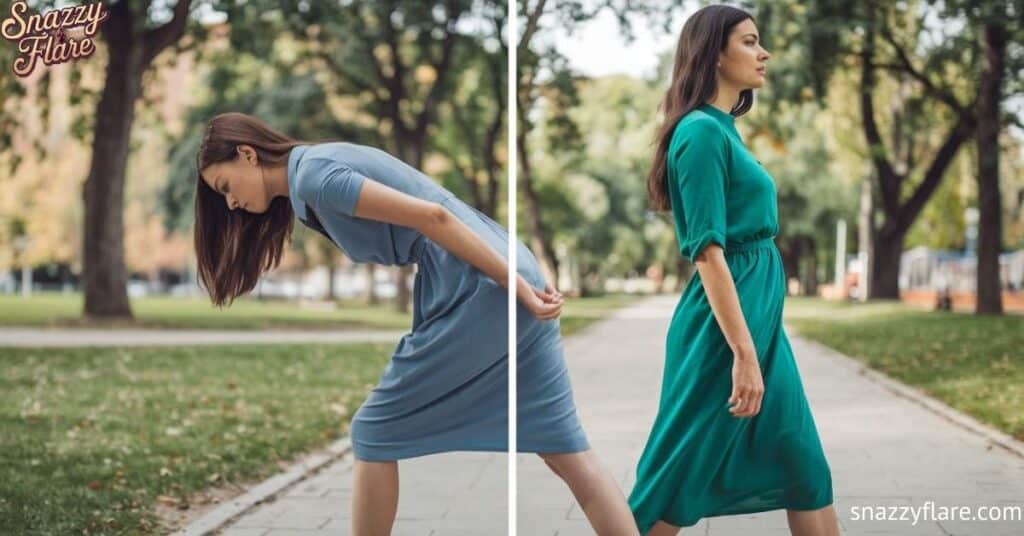
Avoid these pitfalls:
- Leaning too far forward can throw off your balance in heels, putting unnecessary pressure on your toes. Aim to keep your weight centered for a more comfortable walk.
- Taking large steps in heels is challenging and can lead to instability. Smaller, controlled steps offer better balance and make walking in heels feel more natural.
- Looking down while walking can cause you to lose balance and project a less confident appearance. Keep your gaze forward to maintain stability and poise.
- Tensing your legs while walking in heels leads to discomfort and fatigue. Try to relax your muscles, allowing a smooth and natural stride that feels more comfortable.
Maintenance and Care
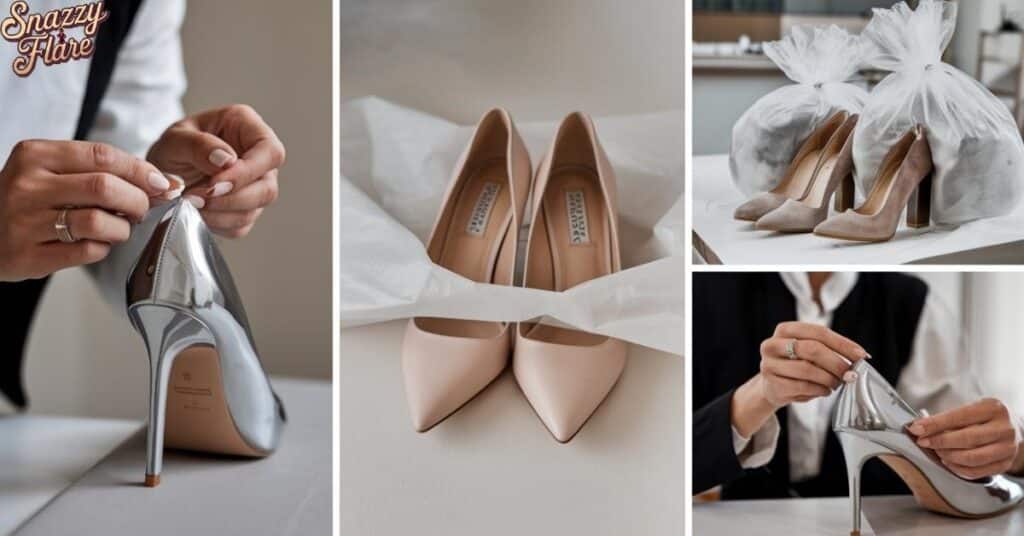
Protect your heels with proper storage, protective soles, and timely repairs to ensure they stay in top condition.
Protecting Your Investment
Extend the life of your heeled shoes with these care tips:
- Use Protective Soles
Adding protective soles to your heels helps prevent wear on the original sole, extending the life of your shoes. These also provide additional grip, reducing the risk of slips. - Store Properly in Dust Bags
Storing heels in dust bags shields them from dust and scratches, keeping them in top condition. This is especially important for preserving delicate materials like suede and leather. - Rotate Your Shoes Regularly
Rotating your shoes prevents overuse and allows each pair time to recover between wears. Giving your heels a break helps maintain their structure and prolongs their lifespan. - Address Repairs Promptly
Tend to any necessary repairs as soon as they appear whether it’s a loose heel cap or worn out sole. Timely repairs keep your shoes looking and feeling new, ensuring they’re always ready to wear.
Seasonal Heels Wearing Strategies
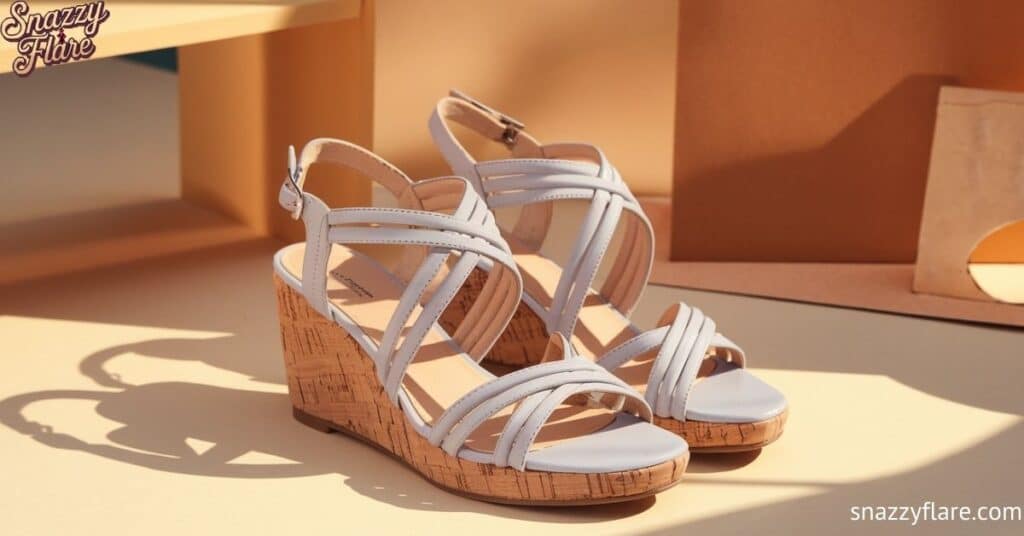
Adapt your heel choices seasonally opt for breathable materials in summer and insulated, water-resistant options in winter.
Summer Solutions for Heeled Footwear
When temperatures rise, try these summer sandals approaches:
- Choose Breathable Materials
Select breathable materials like leather or canvas to keep feet cool. These materials allow airflow, especially helpful during warm seasons. - Opt for Strappy Sandals in Light Colors
Strappy sandals in light colors like beige or pastels suit summer looks and help reflect heat, keeping your feet more comfortable. - Consider Cork or Espadrille Wedges
Cork or espadrille wedges are ideal for warm weather, providing stability while adding a laid back, beachy vibe to your outfit. - Keep a Cooling Foot Spray Handy
A cooling foot spray can instantly refresh your feet on hot days, reducing sweat and discomfort in heels.
Pro Tip: Natural materials like leather and suede allow better airflow than synthetic options.
Winter Weather Navigation
For colder months, prioritize:
- Closed Toe Shoes with Insulation
Opt for closed toe heels with insulation during colder months to keep your feet warm, especially if you’ll be outdoors. - Water Resistant Materials
Choose water resistant materials like treated leather to prevent moisture damage, a must for rainy or snowy weather. - Textured Soles for Grip
Heels with textured soles provide extra traction, making them safer on icy or wet surfaces. - Boot Style Heels for Extra Warmth
For added warmth, consider boot style heels with a thicker sole and insulation, perfect for fall and winter outfits.
What Dresses Can You Wear In The Fall? A Season Guide
Transitional Season Tips
During spring and fall:
- Layer Thin Socks with Closed Toe Styles
Thin socks add warmth without adding bulk, ideal for wearing with closed-toe heels during transitional seasons. - Keep Heels Protectors for Sudden Rain
Heel protectors can save your shoes from water damage during unexpected weather, protecting delicate fabrics and heels. - Choose Versatile Block Heels Shoes
Block heels provide stability, making them an all-season choice for both casual and professional outfits. - Invest in Weatherproofing Sprays
Using weatherproofing sprays on your heels can safeguard them from moisture and stains, essential for unpredictable climates.
Building Confidence in Heels
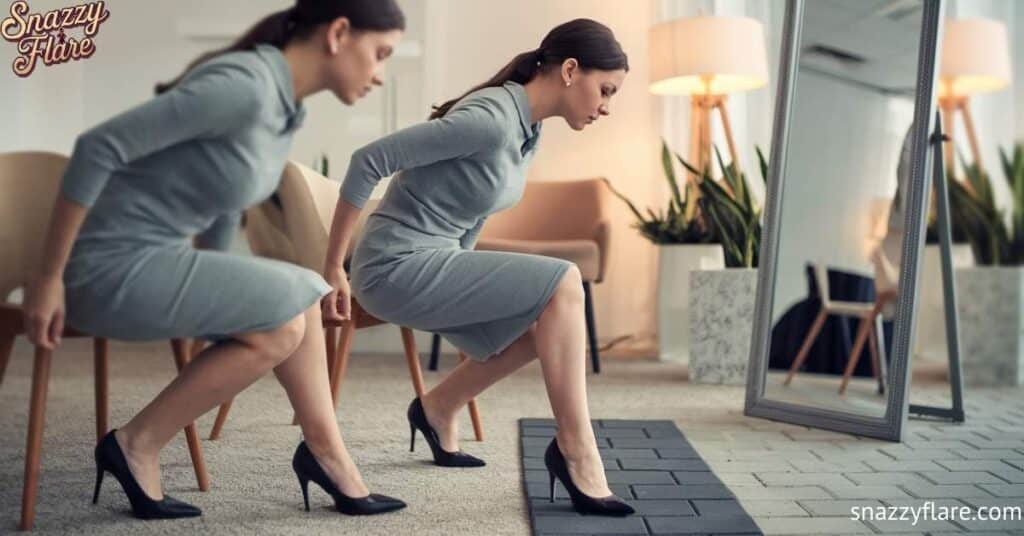
Practice walking in heels on different surfaces, starting small, and gradually building skill to walk with ease.
Practice Makes Perfect
Develop your heel wearing skills:
- Start with 15 Minute Practice Sessions
For beginners, practice walking in heels for 15 minutes daily to build confidence and stability. - Walk on Different Surfaces
Varying surfaces help you adapt to walking in heels, so you’re comfortable in any environment, from pavement to carpet. - Practice Sitting and Standing
Practicing transitions like sitting and standing in heels builds balance and muscle memory for smoother movements. - Record Your Walk for Self Assessment
Recording yourself walking in heels allows you to observe your posture and make adjustments to improve technique.
Emergency Kit Essentials
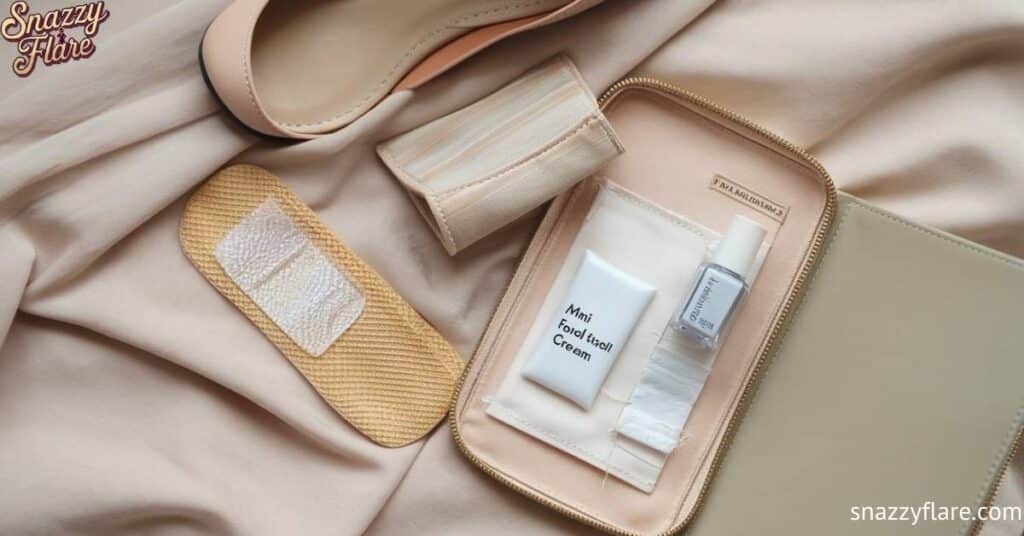
Keep these items handy for comfortable footwear maintenance:
- Blister Prevention Strips: Reduce discomfort with blister prevention strips in high-friction areas.
- Foldable Flats: Keep foldable flats for quick relief during long days or nights in heels.
- Mini Foot Cream: Soothe sore feet with a mini foot cream, providing quick moisture after heel wear.
- Clear Nail Polish: Prevent runs in stockings with a quick dab of clear nail polish.
Expert Solutions for Common Issues
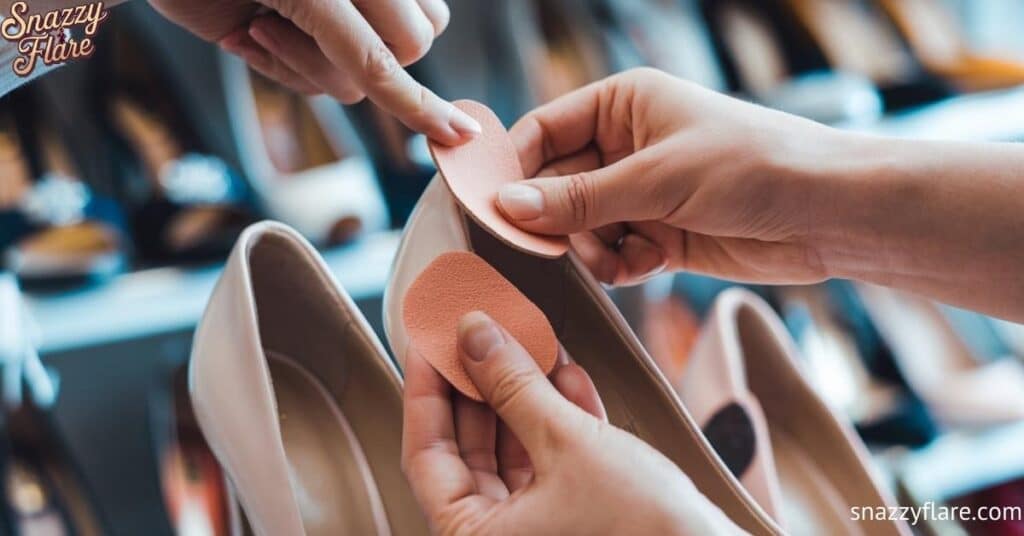
Use insoles, silicone covers, and anti-friction products to prevent heel pain, blisters, and discomfort.
Preventing Heels Pain
Address heel pain before it starts:
- Stretch Before and After Wearing
Gentle stretches before and after wearing heel can alleviate tension and improve foot flexibility. - Strengthen Foot Muscles
Strengthening foot muscles can increase comfort and stamina in heel, as strong feet are less prone to soreness. - Use Appropriate Insoles
Insoles designed for heel offer additional cushioning, absorbing shock to make wearing heel less tiring. - Take Regular Breaks
Taking breaks from heel during long events allows your feet to rest, preventing strain or pain.
Managing High Friction Areas
Protect sensitive spots with:
- Silicone covers reduce pressure on sensitive areas, making heels more comfortable for extended wear.
- Moleskin patches protect areas prone to friction, helping prevent blisters before they start.
- Apply anti-friction sticks to avoid painful rubbing, a must-have for comfort in snug-fitting heel.
- Opt for breathable materials in shoe design to reduce moisture buildup, enhancing overall comfort.
Professional Insights
Podiatrists recommend limiting heel wear to a few hours and varying heel heights to support long term foot health.
Podiatrist Recommendations
Leading foot health experts suggest:
- Limiting High Heels to 6 Hours Max
To avoid strain, aim to limit high heel wear to six hours, giving your feet a needed break. - Alternating Heels Heights Daily
Switching heel heights day to day distributes pressure on different foot muscles, promoting foot health. - Regular Foot Exercises
Incorporate foot exercises to strengthen arches and toes, supporting balance and endurance in heel. - Professional Fitting Sessions
Invest in professional shoe fittings to ensure an ideal fit, reducing discomfort and improving foot alignment.
What jewelry can you wear everyday?
Stylist Secrets for Heels Success
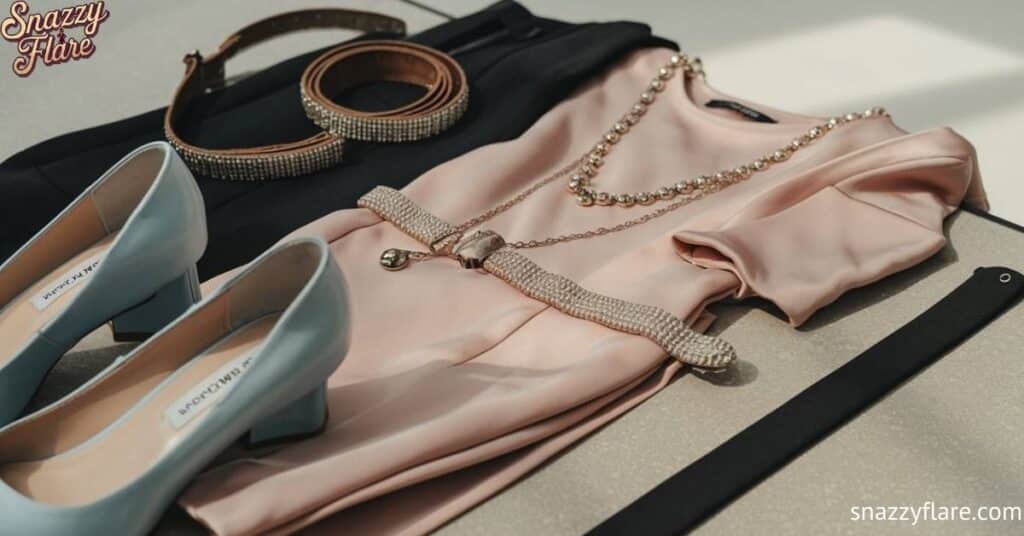
Top stylists recommend:
- Building Outfits from the Shoes Up
Start with your heel as the focal point and build your outfit around them for cohesive styling. - Keeping Spare Low Heels Options
Having a low heel backup offers relief if you need a comfortable switch for longer events. - Coordinating Heel Height with Event Duration
Match heel height to the duration of the event for comfort, opting for lower heel for extended wear. - Matching Heel Style to Outfit Formality
Choose heel that complement the formality of your outfit, aligning style and setting for polished presentation.
14 Stylish Ways to Wear Pearls Without Looking Old-Fashioned
Daily Wear Guidelines
Rotate between heel types and heights to avoid repetitive stress and allow your feet to recover.
How Often Should You Wear Heels?
For optimal foot health when wearing daily heel:
| Activity Level | Maximum Recommended Time | Rest Period |
| Light (Office) | 6-8 hours | 16 hours |
| Moderate (Events) | 4-6 hours | 24 hours |
| Heavy (Dancing) | 2-4 hours | 48 hours |
Creating a Rotation System
For frequent wear, establish:
- 3 Day Rotation Minimum
Using a 3 day rotation between different heel types minimizes wear on shoes and helps your feet recover from pressure points. - Varied Heels Heights
Incorporating varied heel heights in your rotation supports foot health by reducing repetitive strain on specific areas. - Different Pressure Points
Opt for heel that apply pressure on different points of the foot, allowing you to alternate stress zones and prevent soreness. - Mixed Style Types
Choose a mix of heel styles like block, stiletto, and wedges to balance comfort and aesthetics in your wardrobe.
Advanced Styling Techniques
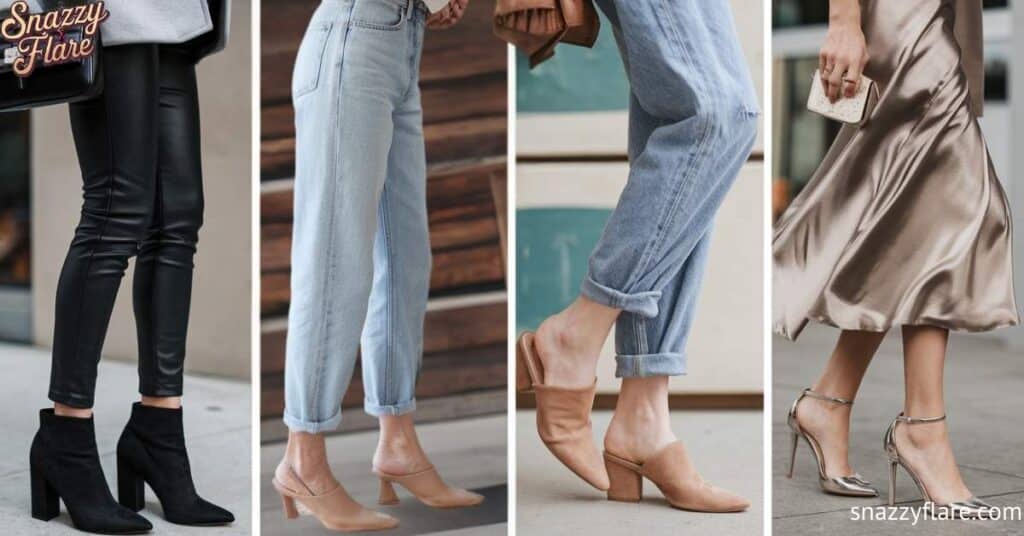
Pair heels with casual or statement outfits to transform your look, from laid-back to refined, with ease.
Elevating Casual Looks
Transform casual outfit ideas with:
- Block Heels Boots with Leggings
Pairing block heel boots with leggings creates a sleek, comfortable look that works well for casual outings and fall outfits. - Wedge Heels Sneakers for Athleisure
Wedge heel sneakers add height to athleisure wear, blending style with comfort for laid-back days. - Kitten Heels Mules with Boyfriend Jeans
Kitten heel mules and boyfriend jeans create a chic yet relaxed look, perfect for weekend brunches or casual nights out. - Stiletto Sandals with Sundresses
For a refined, feminine vibe, pair stiletto sandals with sundresses, ideal for summer events and evening gatherings.
Making a Statement
For dressy occasions, try:
- Metallic Finishes
Add drama to formal outfits with metallic-finished heel that make a bold, eye-catching statement. - Animal Prints
Animal print heel bring flair to neutral outfits, transforming simple looks with a touch of personality and trendiness. - Architectural Heels
For a unique style, architectural heel offer artistic designs, making them a standout choice for fashion-forward events. - Embellished Designs
Heel with embellishments like crystals or studs elevate special occasion outfits, adding a glamorous touch to your ensemble.
Long Term Foot Care Strategies
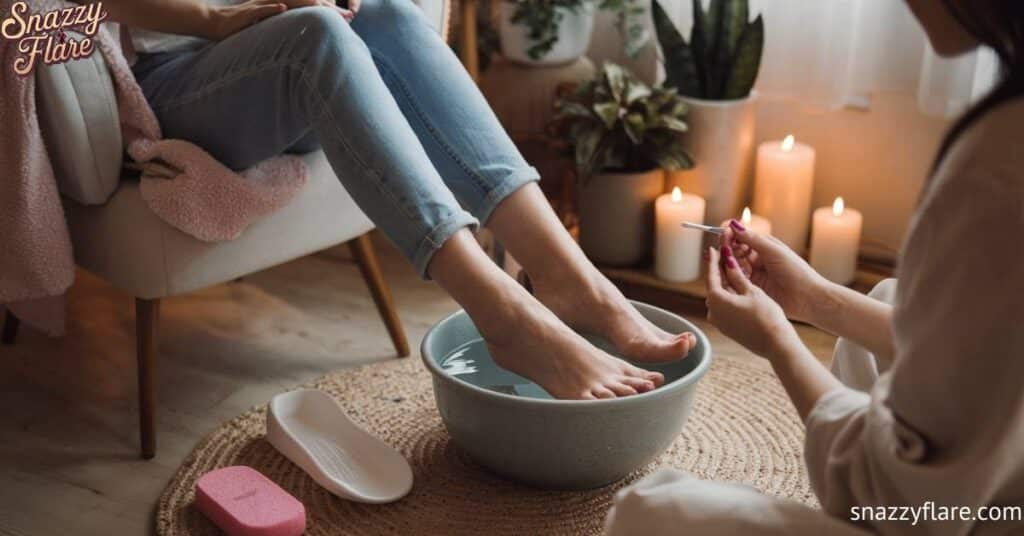
Regular foot exercises, stretching, and professional checkups help keep your feet healthy for heel wear.
Preventive Measures
Maintain healthy feet with:
- Regular Stretching Routines
Incorporate stretching routines for your feet and calves, enhancing flexibility and reducing stiffness from extended heel wear. - Proper Arch Support
Opt for shoes with arch support to relieve stress on your feet and improve comfort when wearing heel for long periods. - Monthly Pedicures
A monthly pedicure keeps your feet in top condition, preventing calluses and maintaining foot health.
Professional Assessments
Regular professional foot assessments help you address any issues early, ensuring long-term comfort and wearability in heel. Recovery Techniques
After wearing heel, practice:
- Ice Roller Massage
An ice roller massage after wearing heel can reduce inflammation and soothe tired feet. - Elevation Periods
Elevate your feet after heel-wearing sessions to improve circulation and reduce swelling, promoting recovery. - Compression Socks
Compression socks help manage any residual discomfort, aiding in muscle recovery and reducing foot fatigue. - Foot Strengthening Exercises
Engage in foot-strengthening exercises like toe curls and resistance work to build muscle resilience, making heel wear more comfortable.
The Psychology of Heels Wearing
Heels can boost confidence and presence practicing positive posture and visualization enhances poise and authority.
Confidence Building
Master the mental aspect of wearing high heel:
- Practice Positive Posture
Maintaining positive posture when wearing heels helps you appear taller and more poised, while also reducing strain on your body. - Visualize Confident Walking
Visualize confident walking before stepping out, imagining each stride with balance and ease. This mental prep can boost your poise and composure. - Start in Comfortable Settings
Begin your heel journey in comfortable settings like home or casual outings to build confidence and control in familiar environments. - Gradually Increase Challenge Levels
As your comfort improves, gradually increase challenge levels by introducing higher heels or different terrains, enhancing skill and adaptability.
Professional Impact
Studies show well-chosen heeled shoes can:
- Increase Perceived Authority
Wearing heel can increase perceived authority in professional settings, as it enhances both your height and presence. - Enhance Professional Presence
Well-chosen heel can enhance professional presence by adding polish and sophistication to your overall appearance. - Boost Self-Confidence
Heel can boost self-confidence by making you feel more empowered, allowing you to carry yourself with assurance. - Improve Posture Awareness
Heel naturally encourage posture awareness, helping you stand taller and project confidence in any environment.
Learn about 48 Dress Types and What They Mean in our guide
Conclusion: Your Personal Heels Journey
Remember these key points for successful heel wearing:
- Start gradually and build tolerance
- Invest in quality over quantity
- Prioritize proper fit and comfort
- Maintain regular foot care
- Choose appropriate styles for occasions
By following these comprehensive guidelines, you’ll master the art of wearing heel while maintaining comfort and style. Whether you’re stepping into your first pair or expanding your collection, these tips will help you walk tall with confidence.
Remember: The best heel is the ones that make you feel both comfortable and confident. Listen to your body and adjust your choices accordingly.

“Jessica Jone is an experienced fashion blogger at Snazzy Flayer. With a passion for style and a keen eye for trends, she shares practical tips and fashion insights to help readers elevate their everyday looks.”
